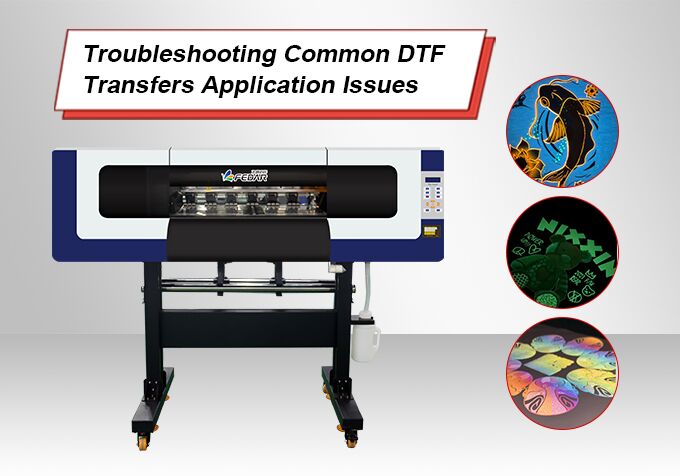03
Mar
Understand how to troubleshoot DTF issues and learn quick solutions for white ink issues, adhesion problems, and more to get awesome prints!

Direct-to-film (DTF) printing is changing custom clothing and promotional products with its vibrant colors and durable prints. However, you can face issues in DTF printing that might affect the quality and longevity of the prints. This article discusses the challenges you might face during DTF transfers and gives easy solutions for them.
Whether you are a newbie or an experienced DTF printer, the following tips will help you in getting consistently good results.
DTF printing involves transferring a printed image from a film to your substrate using a heat press. The process uses special ink and adhesive powders that make the design stick to the fabric. Because DTF printing has multiple steps, each must be managed carefully. Even small mistakes can cost a lot.
Understanding these basics can help you in troubleshooting common issues. By knowing what each step should look like when done correctly, you can quickly identify where things might be going wrong.
If your transfers are not sticking as they should, it is probably because of insufficient curing of the adhesive powder or wrong heat press settings.
Color variations mean incorrect ink settings or some other factors such as temperature and humidity.
White ink is the most important for DTF printing for bright and vivid colors, but it can be challenging to manage.
If the print is uneven or looks patchy, it might be due to an adhesive powder problem or pressure problem during heat pressing.
White ink is an essential component of DTF printing. White ink forms the foundation upon which all the other colors depend to maintain the prints stunning and appealing. White ink could prove difficult to deal with. Listed below are some common problems and how to deal with them:
White ink may thicken or clog if you don't use it often. To prevent this from occurring, ensure that you clean your printer's printhead from time to time. If you detect any clogs, use a cleaning cycle and a cleaning solution that is designed for DTF printers.
If the white ink is not applied uniformly, your design will be uneven. Ensure you verify your printer settings to confirm the white ink density is set correctly. At times, you might need to tweak the ink blend or verify whether the ink cartridge is low.
Applying too much white ink will make the surface rough or spread into the other colors. Change your settings to get the correct amount of white ink and the other colors. Making a few test prints will give you the correct balance before beginning the full print run.
Adhesion issues are the biggest problem with DTF transfers. If your prints are peeling off or not sticking to the fabric, try these troubleshooting steps:
Temperature, pressure, and dwell time are key. Most DTF transfers need 160°C to 170°C (320°F to 338°F) with medium pressure. Make sure you’re following the guidelines for your substrate.
The adhesive powder must be spread evenly and cured before the heat press. If not, the transfer won’t stick to the fabric.
Some fabrics may need pre-treatment to stick better. This might be pre-heating or applying a primer. Check the material specs to see if extra prep is required.
Humidity and temperature in your workspace can affect the adhesion. Work in a controlled environment for better results.
Uneven transfers are brought about by uneven adhesive powder or heat press pressure. The following is how to correct this issue:
Apply the adhesive powder in a uniform manner to the printed film before curing. A calibrated powder applicator is employed for uniform layer application.
Ensure your heat press is pressing evenly over the entire surface and in good working condition. If your press is adjustable, experiment with various pressures to determine what the optimal one will be for your project.
Now and again, inspect and calibrate your equipment. After a while, wear and tear will cause unpredictable performance. Keep your machine maintained and you will have a good, even transfer.
Test print a few first before producing a large batch. This way, you can determine whether you need to adjust the powdering or pressing process.
Troubleshooting DTF transfers is quite easy. By understanding the basics of DTF printing and knowing the common issues like white ink, adhesion problems, and uneven transfers you can solve them easily.
Following best practices – regular cleaning, high-quality materials, and documenting your settings – will reduce issues over time. A well-maintained process not only improves your transfers but also your efficiency, saving you time and money. Keep learning and experimenting and soon troubleshooting will become a part of perfecting your craft.
By following the solutions in this article, you’ll be equipped to handle common DTF transfer issues and get perfect results every time. Happy printing, and may your DTF transfers always turn out great!
If there's anything we can do to further showcase machines' features, please let us know.
Email: sale@fedar.net
Whatsapp: http://wa.me/8615515715397
Our company has over 30 models of printers with independent intellectual property rights and patents. Marketed under the esteemed brands of Skycolor, Stormjet, and Fedar brands, these printers cover a wide range, including digital textile printers, UV printers, eco-solvent printers and more. Known for their exceptional quality and performance.
